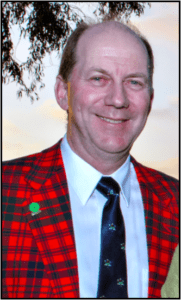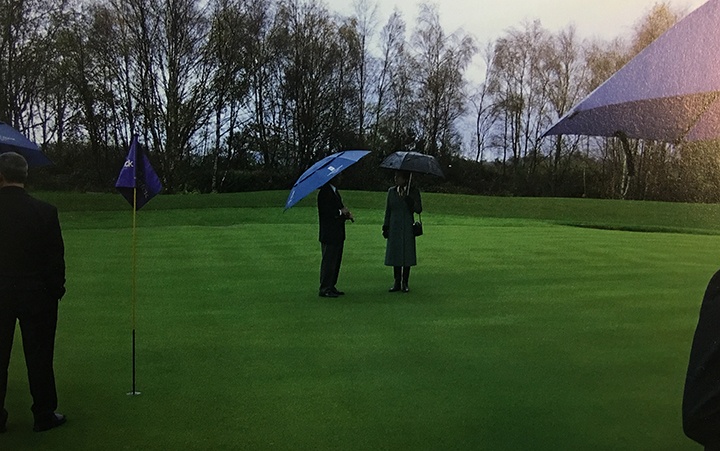 Based in Toronto, Doug Carrick has served on the American Society of Golf Course Architect’s Board of Governors as membership chairman and secretary. He began his career in golf course architecture in 1981 when the late C.E. Robinson schooled Carrick in design principles passed on to him by Stanley Thompson. Carrick founded his own design firm four years later, and it’s become one of Canada’s leading golf course architecture firms. His first solo design, King Valley Golf Club, was voted Canada’s second-best new course by Golf Digest in 1991, and in 1995 his Angus Glen Golf Club earned the top honors from the same magazine. He’s also designed The Carrick at Loch Lomond, Scotland; Fontana Golf Club in Oberwaltersdorf, Austria; and, in Canada, Bigwin Island Golf Club in Lake of Bays, Ontario; Greywolf Golf Course at Panorama Resort; and Osprey Valley’s Resort Course.
Based in Toronto, Doug Carrick has served on the American Society of Golf Course Architect’s Board of Governors as membership chairman and secretary. He began his career in golf course architecture in 1981 when the late C.E. Robinson schooled Carrick in design principles passed on to him by Stanley Thompson. Carrick founded his own design firm four years later, and it’s become one of Canada’s leading golf course architecture firms. His first solo design, King Valley Golf Club, was voted Canada’s second-best new course by Golf Digest in 1991, and in 1995 his Angus Glen Golf Club earned the top honors from the same magazine. He’s also designed The Carrick at Loch Lomond, Scotland; Fontana Golf Club in Oberwaltersdorf, Austria; and, in Canada, Bigwin Island Golf Club in Lake of Bays, Ontario; Greywolf Golf Course at Panorama Resort; and Osprey Valley’s Resort Course.
When I was young and naive, I met a developer who was planning to develop a golf resort on a small island in the Bahamas called Whale Key.
We met in Toronto, and he arrived in a nice Mercedes 450 SL wearing a diamond-studded Rolex watch. He couldn’t have been much more than thirty years old. I remember being impressed, but I also wondered how a guy that young became so wealthy at such a young age. But I didn’t worry, because this was a very exciting opportunity for me: to design my first international course in the Bahamas.
Plans were made to visit the property. The client arranged for us to fly down to Miami with his own pilot, where we would pick up his twin-engine Cessna and fly from Miami to Whale Key.
As we approached the island of Whale Key, the pilot made a pass over the island to make sure that the coral landing strip was clear. As we made our final approach, I noticed debris strewn along both sides of the landing strip; that debris turned out to be from a series of airplane wrecks. The landing was a little tense!
Upon taxiing over to the terminal, which was a wooden shack on the side of the landing strip, we were greeted by the client’s father, who arrived in a beat-up old Ford flatbed truck. I arrived at the old mansion house a little shaken, but in one piece.
We spent the next two days exploring the island through its thick underbrush, trying to determine the best routing for fairways. After all of that dirty work, at the end of the day we were treated to a fine dinner of salami, which was also the meal of choice for breakfast and lunch.
When Sunday arrived, after two exciting days on the island of Whale Key, I was looking forward to flying home to a nice meal of pasta, pork chops or something other than salami, but when I arrived at the lobby of the mansion house with my packed suitcase, the client informed me that we weren’t leaving until Monday.
“But I told my wife that I would be returning home today,” I explained to him. “I need to call and tell her I won’t be home until Monday.”
“No problem,” he said, “but there is no phone on the entire island of Whale Key.”
I must have looked frustrated.
“Not to worry,” he continued. “My pilot can fly you over to the closest island at Chubb Key. There is a pay phone in town. It will allow him to pick up some more salami – supplies are running low.”
So off we went, just the pilot and myself, on our adventure to Chubb Key. The five-minute flight was uneventful. After checking in with the two local Bahamian customs officials brandishing rifles, we ventured into town in search of a phone and, of course, more salami.
Once I’d phoned my wife and we’d finished our business in town, we returned to the airstrip, where we found one of the local customs officials leaning back in his rickety chair, asleep with his rifle resting on his shoulder. We checked in with the official who was awake, and once the pilot filed his flight plan, we were off again into the wild blue yonder.
When the pilot lined up his approach to Whale Key, the setting sun blasted its rays into our eyes, making the runway virtually invisible. Somehow the pilot was able to put the aircraft down before crashing into the jungle at the end of the runway. Another joyful ride back to the mansion house on the three-tired pickup truck allowed us to arrive just in time for another salami dinner.
We dined quietly as the sun set into the Bahamian Sea.
In the middle of dinner, we heard a knock at the door. My client excused himself to answer it. He was greeted by two Bahamian Customs officials from Chubb Key.
“Hello suh. We is customs officers from Chubb Key and we is lookin’ for de two gentlemen dat was in Chubb Key earlier today,” one of the officials said.
“What is this about?”
“We has been informed by some peoples in Nassau dat dey is dealin’ drugs!”
“I’m sorry, but I think you must be mistaken. These two men are here as my guests and I can tell you they are not drug dealers.” The officials shook their heads.
“Our sources tell us dat dey is drug dealers and we has to take dem back to Chubb Key tonight for questioning.”
My client asked the officials how they got to Whale Key.
“We comes here by boat. A nice little Boston Whaler.”
“And you want to take these gentlemen back to Chubb Key tonight, in the dark, in your little Boston Whaler?”
“Yes, we has to take dem for questioning. Dey is drug dealers!”
“Look, they are not drug dealers. One gentleman is here to design a golf course for me on Whale Key, and the other is my pilot! They are not drug dealers and you are not taking them back to Chubb Key!”
This back-and-forth conversation went on for almost an hour, and eventually the client convinced the gun-toting customs officers that we were not drug dealers.
I was never so glad to arrive home after a business trip. I never did design a course for Whale Key and I haven’t eaten salami since.
I did eventually get international design projects, particularly a very special one in Scotland. Designing a course in the homeland of golf has been the biggest thrill of my career so far.
My good friend Ken Siems, who is superintendent of the famed Loch Lomond Golf Club outside Glasgow, recommended me to a gentleman by the name of Mitch Higgens, who was planning to develop a golf resort on the shores of Loch Lomond, next door to Loch Lomond Golf Club. Fate was on my side. I happened to be planning a flight to visit a project we were working on in Spain when Mitch Higgens called one Friday afternoon. I would be flying through Heathrow the following Monday, and so he made arrangements for me to meet Mr. Higgens at Heathrow airport three days later. The meeting went well.
I stayed in close touch with Mr. Higgens over a period of approximately eighteen months while he searched for a financial backer and partner for his Scotland project. Eventually De Vere Resorts, owners of the five-star Cameron House Hotel, located just two miles down the Loch Shore, came to the table to take over the project.
I made another trip to Scotland to meet with the director of De Vere Resort Ownership, Craig Mitchell. Mr. Mitchell and I seemed to hit it off right away and we both shared the same vision for the golf course. He green-lighted the golf course project with me as the designer.
After two years of the planning and another two years of construction, the golf course, which they named The Carrick, was completed. Joe Longmuir, the general manager of Cameron House at the time, made arrangements for HRH Princess Anne to attend a formal opening ceremony for the golf course and the adjacent mansion house time-share development.
My wife Rosa and my two design associates, Cam Tyers and Steve Vanderploeg, made the long trip to Scotland to join in the opening festivities. It was pouring rain when Princess Anne arrived with her various staff members. The princess was to greet the long line of consultants, contractors, and representatives from De Vere inside. We’d all rehearsed our bows and royal greetings, hoping not to embarrass ourselves. Following a series of short and courteous conversations with the princess, we ventured out onto the eighteenth green in the pouring rain, where I handed Princess Anne a royal purple flagstick, which she set into the hole. It was a very special and proud moment.
A few photo opportunities ensued, and just when I was certain the princess had tired of the weather and the perfunctory visit, she surprised me and the others by leading me on a short, private stroll across the eighteenth green. She asked me many questions about the design of the course. The other onlookers were convinced that she was asking me for my phone number, but I’ll never tell!

